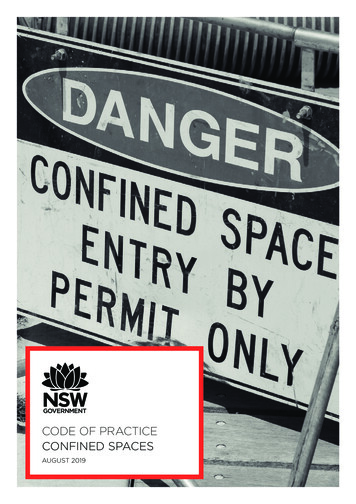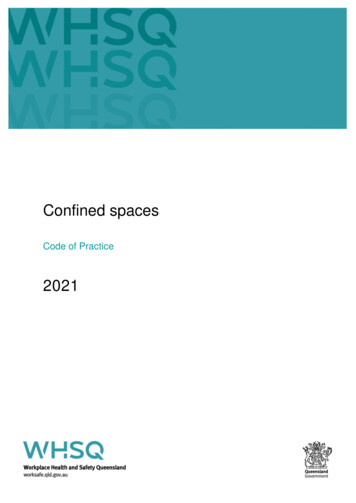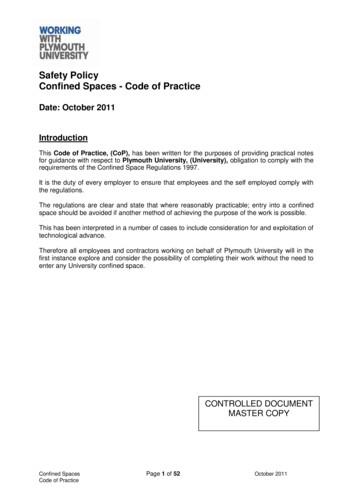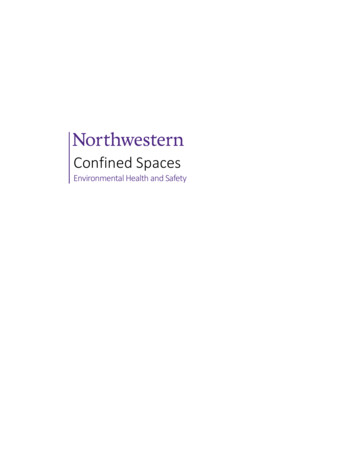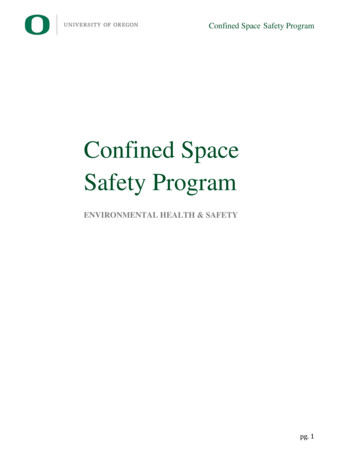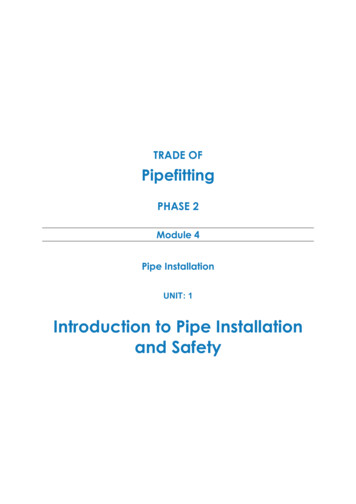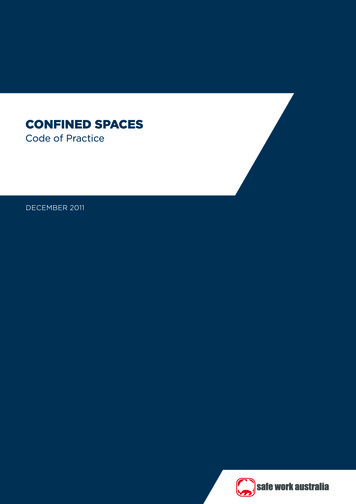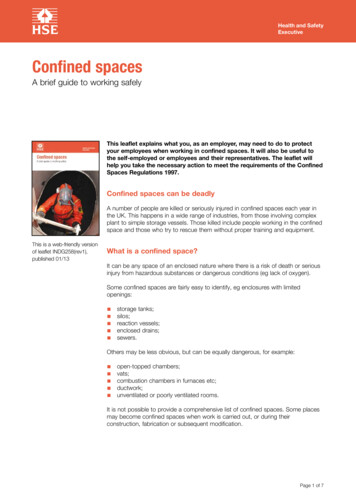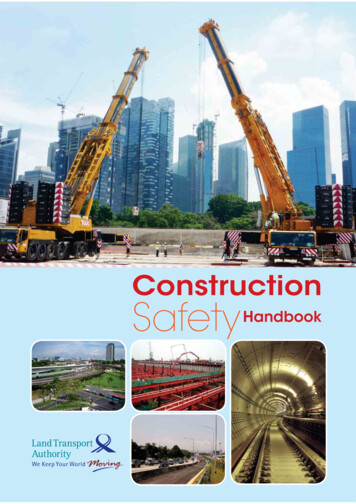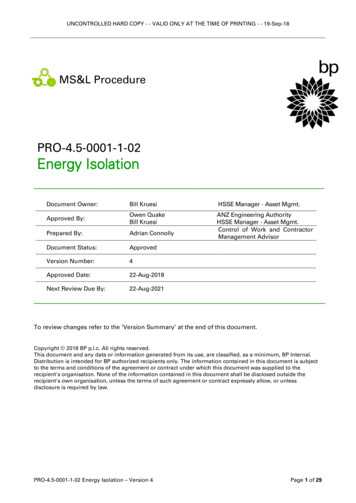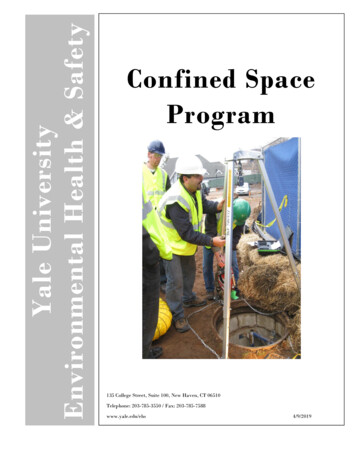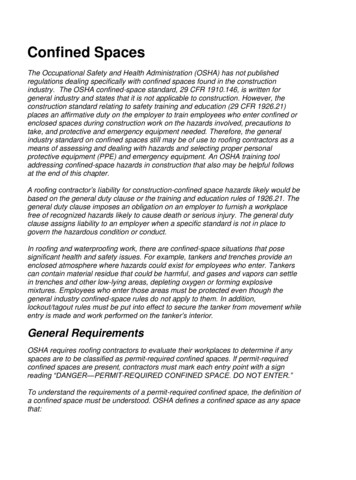
Transcription
Confined SpacesThe Occupational Safety and Health Administration (OSHA) has not publishedregulations dealing specifically with confined spaces found in the constructionindustry. The OSHA confined-space standard, 29 CFR 1910.146, is written forgeneral industry and states that it is not applicable to construction. However, theconstruction standard relating to safety training and education (29 CFR 1926.21)places an affirmative duty on the employer to train employees who enter confined orenclosed spaces during construction work on the hazards involved, precautions totake, and protective and emergency equipment needed. Therefore, the generalindustry standard on confined spaces still may be of use to roofing contractors as ameans of assessing and dealing with hazards and selecting proper personalprotective equipment (PPE) and emergency equipment. An OSHA training tooladdressing confined-space hazards in construction that also may be helpful followsat the end of this chapter.A roofing contractor’s liability for construction-confined space hazards likely would bebased on the general duty clause or the training and education rules of 1926.21. Thegeneral duty clause imposes an obligation on an employer to furnish a workplacefree of recognized hazards likely to cause death or serious injury. The general dutyclause assigns liability to an employer when a specific standard is not in place togovern the hazardous condition or conduct.In roofing and waterproofing work, there are confined-space situations that posesignificant health and safety issues. For example, tankers and trenches provide anenclosed atmosphere where hazards could exist for employees who enter. Tankerscan contain material residue that could be harmful, and gases and vapors can settlein trenches and other low-lying areas, depleting oxygen or forming explosivemixtures. Employees who enter those areas must be protected even though thegeneral industry confined-space rules do not apply to them. In addition,lockout/tagout rules must be put into effect to secure the tanker from movement whileentry is made and work performed on the tanker’s interior.General RequirementsOSHA requires roofing contractors to evaluate their workplaces to determine if anyspaces are to be classified as permit-required confined spaces. If permit-requiredconfined spaces are present, contractors must mark each entry point with a signreading “DANGER—PERMIT-REQUIRED CONFINED SPACE. DO NOT ENTER.”To understand the requirements of a permit-required confined space, the definition ofa confined space must be understood. OSHA defines a confined space as any spacethat:
Is large enough and so configured that an employee can bodily enter andperform assigned workHas limited or restricted means for entry or exit (e.g., tanks, tankers, silos,storage bins, vaults and pits)Is not designed for continuous employee occupancyPermit-required Confined SpacesWhen a roofing contractor determines that confined spaces exist, the next step is todetermine whether the confined space is a permit-required confined space. OSHAdefines a permit-required confined space as a confined space that meets one ormore of the following characteristics: Contains or has the potential to contain a hazardous atmosphereContains a material that has the potential for engulfing an entrantHas an internal configuration such that an entrant could be trapped orasphyxiated by inwardly converging walls or a floor that slopes downward andtapers to a smaller cross-sectionContains any other recognized serious safety or health hazardIf one or more of these conditions exist, a contractor must follow the proceduresdiscussed under the paragraph in this chapter titled “Permit-required Confined SpaceRequirements.”Following this chapter, a sample permit-required confined-space (PRCS) writtenprogram, common in general industry, can be found that can be adapted for inclusionin a company’s overall health and safety program.Atmospheric MonitoringIt is impossible to detect a hazardous atmosphere without instruments designed forthat purpose. It should never be assumed that a confined space is safe or that anemployee will be fine if he or she doesn’t linger in a confined space or performdangerous work there. A person can be overcome in a hazardous atmosphere in amatter of moments. Even quick and simple work in an area not recognized as aconfined space can result in injuries or death by asphyxiation or as a result of anexplosion.In order to enter any confined space without the use of special types of PPE, such asa self-contained breathing apparatus (SCBA), atmospheric conditions must havethese characteristics: Oxygen: 19.5 percent to 23.5 percent
Flammability: below 10 percent of the lower flammable limit (LFL) for gases,vapors, mists or combustible dustToxic gases: below the permissible exposure limit (PEL)/threshold limit value(TLV) or time-weighted average (TWA) of a substanceWhen testing for atmospheric hazards, a contractor should first test for oxygen.Combustible gas meters are oxygen-dependent and will not work properly in anoxygen-deficient atmosphere. Second, a contractor should test for combustible gasesand vapors because the threat of fire or explosion is usually more immediate and lifethreatening. Third, a contractor must test for toxic gases and vapors.All the operations that will be taking place within the space and any hazardoussubstances that may result, such as fumes from welding or vapors from solvents orother chemicals, must be considered. The proximity to traffic and automotive vehicleson site should also be noted because this may generate carbon monoxide.Alternative Entry ProceduresA contractor may allow entry into a permit-required space using alternative entryprocedures. Using these procedures, the contractor does not need to have a writtenprogram, written permit, attendant or rescue team, etc., providing that: The only hazards in the permit space are atmosphericHazards can be controlled by the use of continuous forced-airventilationAtmosphere is tested periodically during entryIt may be necessary, though, to conduct a full permit-required confined-space entryto test the atmosphere if it cannot be tested from outside. Once the atmosphere hasbeen tested and it is determined that the only hazard is an atmospheric hazard thatcan be controlled through the use of forced-air ventilation, the rest of therequirements are relaxed―the only requirement being that the atmosphere must betested periodically.If a hazardous atmosphere is detected at any time during the entry, the following arerequired: Each employee must leave the space immediately.The space must be evaluated to determine how the hazardous atmospheredeveloped.Steps must be taken to protect the employees from the hazardousatmosphere before a subsequent entry takes place.Once the contractor satisfies the requirements for entering using alternative entryprocedures, certification must be completed before anyone enters the confined
space. The certification consists of the date, location of the space and signature ofthe person providing the certification.Nonpermit-required Confined SpacesPermit-required confined spaces may be reclassified as nonpermit-required confinedspaces if certain criteria are met. If these criteria are met, rescue teams, special PPE,etc., are not required. The criteria include the following: The space poses no actual or potential hazardous atmospheres.All hazards within the space can be eliminated without entry into the space,such as locking and tagging equipment so it cannot be operated whileemployees are working inside.Forced-air ventilation to control atmospheric hazards does not constituteelimination of hazards.A contractor must verify these conditions are met through certification, which is thesame as the alternative entry procedure. Again, the date, location of the space andname of the person certifying the space must be on the certificate. This certificatemust be made available to employees before entering the space.If hazards arise in a confined space that has been declassified, each employee mustexit the space. The contractor must determine if the space needs to be reclassifiedas a permit-required confined space. If the hazards are eliminated, the nonpermitentry can continue.It is important to note that the difference between an alternative entry procedure anda nonpermit-required confined space is the use of forced-air ventilation. If forced-airventilation is used during an entry, it cannot be classified as a nonpermit-requiredconfined space. It must be classified as an alternative entry procedure.It is in the best interest of the contractor to try to meet the requirements of alternativeentry procedures or nonpermit-required confined spaces because the requirementsfor the two are much less stringent than for a permit-required confined space.However, it imposes the burden of making certain the conditions inside the space donot change.If a contractor can neither declassify a permit-required confined space to anonpermit-required confined space nor use alternative entry procedures, all aspectsof permit-required confined spaces must be followed.Permit-required Confined Space RequirementsIf a contractor’s employees are required to enter permit-required confined spaces, awritten program must be developed addressing all potential hazards. The programmust address the following topics:
Implementation of measures necessary to prevent unauthorized entry into thepermit-required confined space. This can be done by informing thoseemployees who have not been trained in the standard to keep away during theentry activities. Using appropriate signs and barricades to prevent entry wouldbe sufficient.Identification and evaluation of hazards in the permit space before employeesenter itDevelopment of procedures and practices necessary to conduct safe permitspace entries, including at least the following elements:– Specification of acceptable entry procedures. This includes having anoxygen content between 19.5 percent and 23.5 percent, LFL ofsubstances below 10 percent and below established PELs, TWAs andTLVs.– Isolation of the permit space. This includes locking and taggingequipment to prohibit use while the entry is taking place. For example,a tanker must be prevented from being driven away.– Control or elimination of atmospheric hazards through purging, inerting,flushing or ventilating– Protection of pedestrian or vehicular traffic from hazards by usingbarriers– Verification that the conditions in the permit space remain at safe levelsthroughout the entry. Maintenance of equipment to ensure safe entry into a permit space, whichinvolves:–––– Gas-detection equipmentVentilating equipmentCommunication equipment if necessaryPPE to be used when engineering controls such as ventilationequipment is not practical– Lighting– Barricades to prevent unauthorized entry– Equipment, such as ladders, to provide for safe access to and egressfrom the permit space– Rescue and emergency equipment, unless this service is provided– Any other equipment that would be used for safe permit space entryEvaluation of permit space conditions during entry operations by:– Testing conditions in the permit space before entry begins– Testing or monitoring the space to ensure the conditions are beingmaintained
– Testing for oxygen first, flammable atmospheres second and toxicatmospheres last Provision of at least one attendant outside the permit space (an explanation ofduties and training requirements of the attendant follows)Designation of employees who have active roles in entry operations andidentification of the training requirements for those employeesDevelopment and implementation of procedures for summoning rescue andemergency servicesDevelopment of a permit system to include preparation, issuance, use andcancellation of permitsCoordination of entry operations when more than one employer is involvedCancellation of a permit after the work is completeReview of entry operations to correct problems that may have occurred duringthe entry operationReview of the written program annually, making revisions as neededPermit SystemAs stated before, OSHA requires employers to develop and implement a permitsystem. This system will ensure all steps have been taken to protect employees fromhazards that may be in a confined space. Two sample permits are included at theend of this chapter.Entry supervisors are required to sign the completed permit, authorizing the permitoperations to begin. Authorized entrants must have the opportunity to review thepermit before they enter the permit space. Also, a copy of the permit must be postedat the entry point of the space.An estimated time for an entry operation must be provided on the permit. Once thetime has expired, the permit is canceled and the operation must cease. In addition,the entry supervisor must cancel the entry when the operation is complete or when acondition arises in the space that was not allowed under the original permitconditions. Unpermitted conditions must be noted on the entry permit.The permit must be retained for one year so it can be reviewed when the writtenprogram is reviewed.TrainingOSHA requires contractors to provide training for those who may be involved in thepermit-required confined-space process. Training must be conducted beforeemployees are first assigned duties relating to confined spaces or if there is a changein their assignments. Training must also be conducted when new hazards ariserelating to permit-space operations where employees have not received prior
training. Also, training must be provided to each affected employee whenever thecontractor believes there are deviations from the permit-space entry.Contractors must train their employees so they are proficient in the duties of anauthorized entrant, attendant or entry supervisor. All training must be certified,indicating employees’ names, trainers’ signatures or initials, and dates of training.Authorized EntrantsAuthorized entrants are employees who have been trained and approved to enter aconfined space. These employees must have had training regarding the potentialhazards of the confined space, as well as the signs and symptoms of overexposureto any of the hazards. They should be familiar with all equipment, know if theequipment is explosion-proof, and know how to tell when it is properly grounded.Authorized entrants must know how to communicate with the attendant, especially ifa prohibited condition or a hazardous situation arises. Entrants must agree to exitimmediately if an order is given to do so or an alarm goes off. Entrants must wearfull-body harnesses with retrieval lines attached to the center of their backs or abovetheir heads or wristlets if full-body harnesses are shown to be infeasible.Authorized AttendantsAuthorized attendants must be able to monitor situations inside and outside confinedspaces so they can order entrants to evacuate a space if a dangerous situationarises in either place. Attendants must be well aware of the hazards of the confinedspace and also aware of the physical and behavioral effects of hazard exposure sothat they would notice the effects in any of the entrants. If an emergency situationarises in the confined space, the attendant is the person responsible for summoningemergency services and performing whatever rescue operation he or she has beentrained and equipped to perform. Another responsibility is keeping all unauthorizedentrants out of the confined space. Under no circumstances is an attendant permittedto leave the space until replaced by another attendant or all entrants have come outof the space.Entry SupervisorsEntry supervisors must know the hazards of confined spaces and the signs andsymptoms of overexposure to those hazards. They must verify that permits are filledin, the appropriate testing and procedures have been completed, and all equipmentis in place. The supervisor is the person responsible for knowing when and underwhat conditions to cancel a permit and terminate the work. Supervisors must alsoremove unauthorized persons. Finally, they are responsible for making sure rescueservices are available and the means for calling them are operable.Rescue and Emergency Services
Contractors who decide to have their employees enter a permit space must providerescue and emergency services. There are three different types of emergency rescuethat a contractor can rely on:1. In-house rescue services2. Outside rescue services, such as local fire departments3. Nonentry rescuesTraining for in-house rescue services requires employees to be trained in the rescuegear they would need to extract someone from a confined space. Because therescuers need to enter the permit space, they must also receive the same level oftraining that authorized entrants receive. Once every 12 months, rescuers mustsimulate an actual rescue using real people or mannequins. At least one member ofthe in-house rescue team must be trained in first aid/CPR.The second option, summoning an outside rescue team to perform the rescue, is amore difficult option with which to comply. A contractor must evaluate the prospectiverescue team to determine how quickly it is capable of responding after members.OSHA requires the rescue team to respond in a timely manner, consistent with thespecific hazard in the confined space.As an example, if there is an immediately dangerous to life and health (IDLH)atmosphere in the permit space and entrants are required to wear self-containedbreathing apparatus (SCBA), the contractor must have a standby person who iscapable of entering the space in a short period.The contractor must select a rescue team that has the capability to reach any victimwithin a time frame that is appropriate for the hazard in the permit space. The rescueteam must be proficient in performing the needed rescue service. The contractormust also inform the rescue team of all types of permit-required confined spaces theyhave and give them time to practice and develop rescue plans.The last option is to provide nonentry rescues. If this option is selected, the personentering the confined space must wear a full-body harness with a retrieval lineattached to it. The retrieval line must be attached to a mechanical device, such as atripod and winch or a fixed point outside the permit space. This will allow someone topull an incapacitated victim out of the confined space.Material safety data sheets (MSDSs) for chemicals to which an entrant was exposedin a confined space are required to be made available to the medical facility thatprovides aid.
Sample Written ProgramPermit-required Confined Space(PRCS) Written Program[Company name] recognizes that entry into confined spaces can kill or injureemployees. The following work practices have been implemented to minimize thepotential dangers associated with entry into permit-required confined spaces.IntroductionThis program identifies specific responsibilities of different parties and presents thecriteria required for safe entry into permit-required confined spaces.Definitionsconfined space: A space that has limited or restricted means of entry, is not designedfor continuous occupancy, and is large enough and configured so that a person canenter the space and maneuver well enough to perform tasks.permit-required confined space: A confined space that has the potential to exposepersonnel to hazards that require controls to prevent injury or death. These hazardsmay include any or all of the following: Engulfment and/or entrapment Hazardous atmospheres Other serious safety or health hazardshazardous atmosphere: An atmosphere that may expose an entrant to the risk ofdeath, incapacitation, impairment of ability to self-rescue (that is, to escape unaided),injury or acute illness from one or more of the following causes: Atmospheric oxygen concentrations less than 19.5 percent or greater than23.5 percent Flammable gas, vapor or mist at a concentration in excess of 10 percent of thelower flammable limit (LFL) Airborne combustible dust at a concentration that meets or exceeds its LFL
Atmospheric concentration of a toxic substance that exceeds its dose orpermissible exposure limit (PEL) Any other atmospheric concentration that is immediately dangerous to life andhealthnonpermit-required confined space: A confined space that does not have thepotential for containing atmospheric conditions capable of causing injury or death.General Procedures Based on these definitions, management is responsible for determiningwhich areas are considered confined spaces and which confinedspaces are permit-required confined spaces. Immediately after identifying the permit-required confined spaces, signsreading “DANGER—PERMIT-REQUIRED CONFINED SPACE. DONOT ENTER,” or similar, must be placed at each entrance of theconfined space. Before allowing entry into any permit-required confined space, thefollowing steps must be followed: An atmospheric test should be performed in the confined spaceto ensure the required ambient conditions—less than 10 percentLFL, greater than 19.5 percent and less than 23.5 percentoxygen, and less than the PEL of a contaminant—exist.The space should be free of other hazards by locking andtagging out equipment as necessary.External rescue services need to be identified or the companyrescue group notified.The permit has be completely filled out, reviewed by entrantsand posted near the permit-required confined space’s entrance.Authorized employees, attendant(s) and entry supervisor(s)should be properly trained regarding all issues in the trainingsection.Ventilation systems must be used as required.Training and ResponsibilitiesGeneral Training Requirements
Each employee at [company name] who is involved or has the potential to beinvolved in confined-space entries must be trained before entering any space, as wellas: Before first assigned duty in a confined space Whenever there is a change in the employee’s duties or assignment Whenever there is a change in the permit space itself Whenever it is determined that there have been or must be changes inor deviations from proceduresIt is also important that employees fully understand the roles and trainingrequirements of attendants, entrants and entry supervisors.Upon completion of training, [company name] will issue certificates indicating eachemployee’s name and identification number, such as social security number; dates oftraining; and name of the trainer.Training Requirements and Responsibilities of Entry Supervisors Know, understand and ensure the completion of the trainingrequirements of the authorized entrants and attendants as outlined intheir requirements and responsibilities. Ensure the entry permit is completely and properly filled out and verifythat the air monitoring has been done correctly. Terminate the permit when conditions change either inside or outsidethe space or when the permit expires. Verify that either external or internal rescue services are available. Determine when responsibility for a permit space is transferred, andensure operations remain consistent with the terms on the entry permit. Require all unauthorized entrants to leave the permit area. Know the signs and symptoms of exposure for the hazardousatmospheres encountered in each confined space.Training Requirements and Responsibilities of Authorized Entrants Be properly trained on all anticipated hazards of permit-requiredconfined spaces.
Know how to use all equipment properly. Know the signs and symptoms of exposure to hazardous atmospheresand how to perform self-rescue. Know the evacuation signal, and understand that the attendant caninitiate immediate evacuations requiring all entrants to exit. Remain in constant communication with the attendant. Alert the attendant when: The entrant recognizes any warning signs or symptoms ofexposure to a dangerous situation.The entrant detects a condition that is not allowed on the permit.Training Requirements and Responsibilities of Attendants Know the hazards that may be encountered during entry, includingsigns and symptoms of exposures and exposure consequences. Remain outside the space at all times, and be in constantcommunication with the entrants. Under no circumstances is anattendant allowed to leave the entrance area of the confined space orperform duties that will interfere with the primary responsibility ofcommunicating with those inside the confined space. Continuously maintain a proper count and be able to identify all theentrants. Monitor activities inside and outside the confined space to ensure thesafety of the entrants. Summon rescue or other emergency personnel when needed. Perform nonentry rescues when possible. Warn all unauthorized entrants of emergencies.Entering the SpacePermit System
Prior to confined space entry, the permit must be filled out completely.The entry supervisor must sign the permit before personnel enter thepermit-required confined space. The completed permit must be posted at the entry point of the confinedspace so entrants can review it and confirm that the pre-entry stepshave been taken. The permit is only valid for the duration of the work performed. The entry supervisor must terminate the permit when: Work is completeConditions arise that were not accounted for on the originalpermitAfter the completion of the entry, the permit will be retained for a periodof one year to facilitate review of the PRCS program. Any problemsencountered during the entry must be noted on the permit and used forreview.Atmospheric Monitoring Before an employee enters any confined space, atmospheric testingwill be conducted to assess the ambient conditions inside the space. The testing will be performed by a qualified person who is capable ofoperating the atmospheric testing equipment and interpreting theresults. The equipment must be capable of detecting a minimum of threehazardous atmospheric variables: flammability, oxygen content andtoxicity. The devices must be equipped with audio alarms, visual alarms or both. Before use or according to the manufacturer’s scheduled specifications,the atmospheric equipment must be calibrated with the specifiedcalibration gases in order to properly identify possible hazardousatmospheres. Acceptable atmospheric limits are: Oxygen content: between 19.5 percent and 23.5 percentFlammability: less than 10 percent of the lower flammablelimit (LFL) for any substance
Toxicity: less than the permissible exposure limit (PEL) asestablished on the material safety data sheets (MSDSs) If the atmospheric monitoring equipment detects levels beyond theseranges, employees will not be permitted to enter the space. If levels rise above or fall below the required ranges while employeesare in the confined space, the entry will be terminated and the attendantwill instruct all employees to evacuate the space. The space will be ventilated and rechecked with the atmosphericequipment before subsequent entry is permitted. In most instances,[company name] will be required to operate the atmospheric equipmentcontinuously. Ventilation equipment will be used when entering any space withoutrespiratory protection. Examples of this type of space include but arenot limited to tankers and waterproofing excavations. This program is not limited to roofing projects; it also applies to tasks orwork performed in the shop area, including in vaults or enclosed areaswhere chemicals are stored. These areas will be determined by theshop foreman and properly marked with appropriate signs.Personal Protective Equipment Work and/or rescue equipment will be immediately available at alltimes. Work and/or rescue equipment will be selected with the potentialhazards and possible contingencies associated with the confined spacein mind. As necessary, PPE will be worn to protect entrants from the hazardsassociated with the confined space. PPE may include eye protection,hearing protection, hand protection, hard hats, chemically treatedprotective garments, and respiratory protection, including self-containedbreathing apparatus (SCBA) if necessary. If the confined space has a height of more than 5 feet with an entrypoint overhead, each entrant will be required to wear a body harnessattached to a mechanical retrieval system, such as a tripod. If the confined space is less than 5 feet in height but has a potentiallyhazardous atmosphere, each entrant will wear a body harness attachedto a lifeline that will be monitored by the attendant. This system will
allow the attendant to perform a non-entry rescue, if necessary, bypulling the entrant out by the lifeline. If the confined space entry requires more than one entrant using anairline system, the attendant will be responsible for ensuring the airhoses and lifelines do not become entangled.General Safety Issues: Under no circumstances will compressed gas cylinders such as thosecontaining oxygen or acetylene be allowed inside the confined space. The only pressurized cylinder that will be permitted is a SCBA forrespiratory protection. If welding or cutting activities are conducted in the confined space, thefollowing must be adhered to: Hoses and torches will be inspected before use. If any piece ofequipment is found to be defective, it will be tagged andremoved from service immediately.A fire watch will be posted during and after the confined spaceentry is complete.All torches and hoses will be removed after work has ceased. Lockout/tagout procedures will be followed on all applicable equipment. When natural lighting is not sufficient, additional lighting will beprovided. It must not exceed 12 volts in damp conditions and will beequipped with a ground fault circuit interrupter. In hazardousatmospheres, explosion-proof lighting will be required. Communications will be established and used throughout the entireconfined space entry. Properly rated fire extinguishers will be present, f
confined space. It must be classified as an alternative entry procedure. It is in the best interest of the contractor to try to meet the requirements of alternative entry procedures or nonpermit-required confined spaces because the requirements for the two are much less stringent than for a permit-required confined space.
